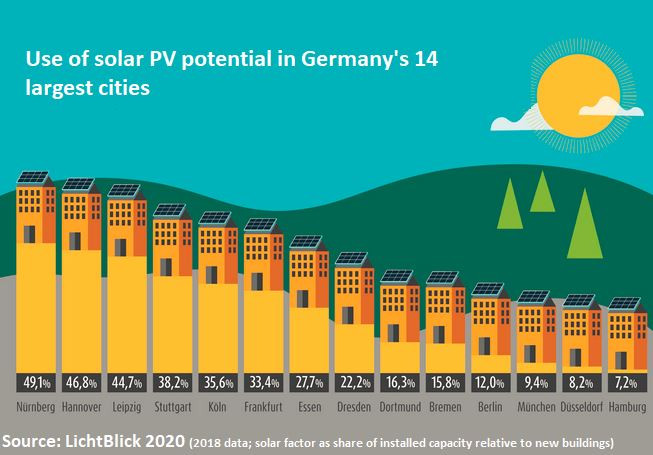Most German cities are wasting vast solar potential on their rooftops – analysis
Clean Energy Wire
Many of Germany's biggest cities are squandering vast renewable energy generation potential by leaving their rooftops empty of solar PV installations, an analysis by renewable power provider LichtBlick has shown. The company said there is great variety among the country's 14 largest cities in how well they are exploiting the area available to solar power, with Nurnberg and Hannover using almost half of all roofs for energy generation while Munich and Hamburg reach less than ten percent. LichtBlick defined a city's solar potential as the ratio between new buildings and newly installed solar PV projects in 2018. "The result is that the potential on rooftops is hardly exploited in most of Germany's metropolitan areas," the company said, adding that every new roof without an installation is a "wasted opportunity" to produce renewable power close to where it is consumed. LichtBlick's Ralph Kampwirth said rooftop solar power would be the best way "to get the energy transition into inner cities" and give rural dwellers some relief from bearing the brunt of renewable energy installations. If Munich and Hamburg had fully used their solar potential, they could have provided solar power to more than 10,000 additional households in 2018 alone and Berlin more than 16,000, the company argued.
With solar power production climbing to unprecedented heights in Germany in the first months of 2020, calls are growing louder to better use the potential of the technology that has seen costs falling substantially over the past years. Rooftop installations have been singled out for warranting special attention since they mostly do not compete over area with other forms of use and produce electricity right where it is used, with home storages able to provide extra flexibility to users. Germany's government coalition was set to resolve a long-lasting dispute over solar support together with other renewable energy legislation on Thursday that was seen as a major obstacle to better exploit solar power's potential.


